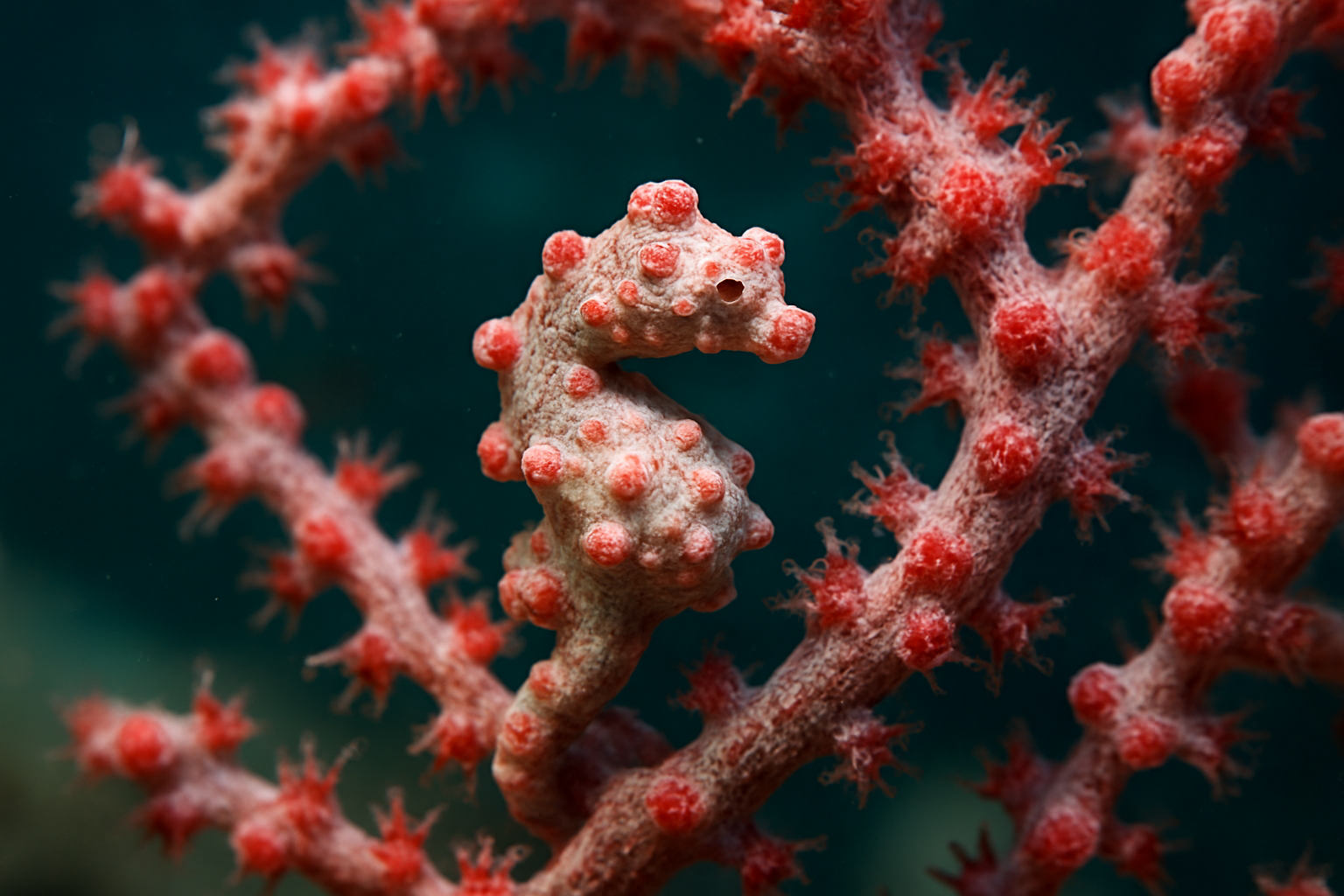The Hidden World of Pygmy Seahorses: Nature's Tiny Marvels
Dive into the mesmerizing realm of pygmy seahorses, where miniature marvels defy expectations and challenge our understanding of marine life. These diminutive creatures, no larger than a fingernail, have captured the hearts of marine biologists and underwater photographers alike. Join us as we explore the fascinating world of these elusive sea dwellers, uncovering their unique adaptations, complex behaviors, and the critical role they play in coral reef ecosystems.

A Masterclass in Camouflage
The remarkable camouflage of pygmy seahorses is not just a matter of coloration. These tiny creatures have evolved specialized adaptations that allow them to perfectly mimic the texture and structure of their coral homes. Their bodies are covered in tiny tubercles, which match the polyps of their host corals. This incredible mimicry extends to their very physiology, with some species developing skin filaments that resemble the coral’s branches.
Unique Reproductive Strategies
Like their larger seahorse cousins, pygmy seahorses exhibit a fascinating reversal of traditional gender roles in reproduction. The male carries and gives birth to the young, a trait that continues to intrigue scientists. The female deposits her eggs into the male’s specialized brood pouch, where they are fertilized and develop. After a gestation period of about two weeks, the male gives birth to fully formed, miniature replicas of the adults, each no larger than the head of a pin.
Habitat Specialization and Threats
Pygmy seahorses are found exclusively in the coral reefs of the Indo-Pacific region, with each species often specializing in a particular type of coral or sea fan. This extreme habitat specialization makes them particularly vulnerable to environmental changes and habitat destruction. Climate change, ocean acidification, and destructive fishing practices pose significant threats to these delicate creatures and their coral homes.
Conservation Efforts and Research Challenges
The conservation of pygmy seahorses presents unique challenges due to their small size and specific habitat requirements. Current efforts focus on protecting their coral reef habitats through marine protected areas and sustainable fishing practices. However, studying these tiny creatures in their natural environment is extremely difficult, limiting our understanding of their population dynamics and long-term survival needs.
The Impact on Marine Tourism
The discovery of pygmy seahorses has had a significant impact on the marine tourism industry, particularly in the diving sector. Enthusiasts from around the world travel to tropical destinations hoping to catch a glimpse of these elusive creatures. This has led to the development of specialized “muck diving” tours, focusing on small and unusual marine life. While this interest has raised awareness about marine conservation, it has also raised concerns about the potential disturbance to pygmy seahorse habitats.
Advancements in Underwater Photography
The challenge of capturing images of pygmy seahorses has pushed the boundaries of underwater macro photography. Specialized equipment and techniques have been developed to document these tiny subjects without causing harm. High-magnification lenses, advanced lighting systems, and innovative camera housings are now used to reveal the intricate details of pygmy seahorses to the world. These photographic advancements have not only benefited scientific research but have also allowed the public to appreciate the beauty of these miniature marvels.
Future Research and Discovery
As technology advances and our ability to explore the oceans improves, scientists anticipate the discovery of new pygmy seahorse species. Current research focuses on understanding their life cycles, population dynamics, and the intricate relationships they have with their coral hosts. Genetic studies are also underway to unravel the evolutionary history of these fascinating creatures and their place in the broader seahorse family tree.
The Pygmy Seahorse in Aquarium Trade
The extreme habitat requirements and specialized diets of pygmy seahorses make them unsuitable for the typical home aquarium. However, their unique appearance has sparked interest in the aquarium trade. Efforts to breed pygmy seahorses in captivity have been largely unsuccessful, highlighting the importance of in-situ conservation efforts. The estimated price for a single pygmy seahorse, if available, could range from $1,000 to $5,000, reflecting their rarity and the challenges of their care.
Lessons in Biodiversity
The story of pygmy seahorses serves as a powerful reminder of the incredible biodiversity hidden within our oceans. These tiny creatures challenge our perceptions of marine life and underscore the importance of protecting even the smallest members of coral reef ecosystems. As we continue to explore and understand the complexities of ocean life, pygmy seahorses stand as a testament to the wonders that await discovery in the vast, blue depths of our planet.





